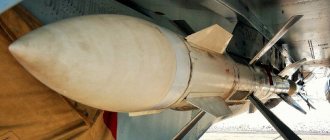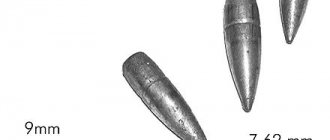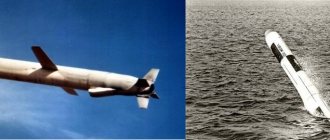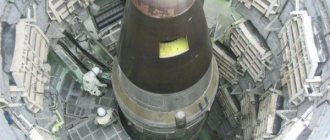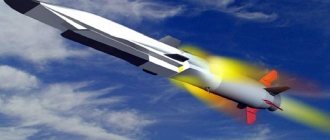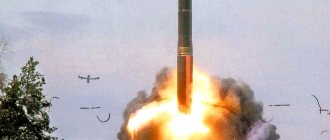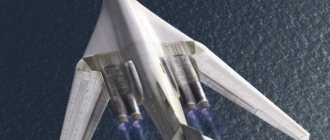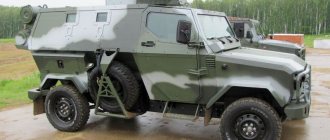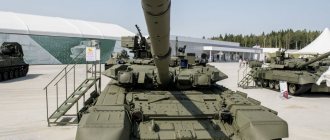| OKR "Caliber" | |
| NATO code: SS-N-27 "Sizzler" | |
| Layout of the export version 3M-54E | |
| Type | long range cruise missile |
| Status | in service |
| Developer | OKB "Novator" |
| Years of development | 1983 |
| (KR), NITI(B) (VU)[1] | |
| Main operators | Russia |
| Other operators | India China Algeria |
| Media files on Wikimedia Commons | |
This term has other meanings, see Caliber (meanings).
OKR "Caliber"
(previously combined with
the Turquoise design and development project
) - Russian cruise missiles, according to NATO codification
SS-N-27 “Sizzler”
(from English - “hell” [2], a very hot day [3]). Developed and produced by OKB Novator.
Content
- 1 History of creation
- 2 Missile nomenclature
- 3 Performance characteristics 3.1 Performance characteristics of missiles in export version
- 3.2 Radar head ARGS-54E
- 3.3 Radar head ARGS-14E
- 4.1 Marine systems
History of creation[edit | edit code]
Sketch of the 3M-54E
anti-ship missile system The Caliber family missiles were created on the basis of two projects: the 3M10 strategic nuclear cruise missile with a combat radius of 2500 km developed during the period from 1975 to 1984 at the Novator SMKB and the Alpha anti-ship missile competition (ROC) "Turquoise").
Initially, only the Yakhont supersonic anti-ship missile missile took part in the Turquoise R&D competition, but its development was delayed and the missile turned out to be expensive. At the same time, the 3M10 project encountered problems due to the upcoming Intermediate-Range Nuclear Forces Treaty. And the Novator Design Bureau, on its own initiative, in 1986 proposed a non-nuclear version of the naval version of the KS-122 missile for competition, however, it did not suit the selection committee due to the subsonic attack speed. Work continued, and in 1990 a finished version appeared with a supersonic final booster to overcome enemy defense systems. However, the beginning of the collapse of the USSR suspended the introduction of this product.
Also, in parallel, the development of an anti-submarine complex based on the KS-122 was carried out to replace the bulky and obsolete Vodopad and Rastrub-B complexes. The first version of a missile in this direction was presented in 1997.
The Caliber family of missiles were first presented to the general public at MAKS-93.
On January 8, 2020, reports appeared in the media about the start of work on the development of a modified version of the Caliber-M missile. According to the source, “The latest high-precision ship-based cruise missile “Caliber-M” with a maximum firing range of more than 4.5 thousand km is being developed for the Navy. The creation of the rocket is at the research stage and is funded by the Ministry of Defense."
. The rocket does not have to be 533 mm caliber.
The source added that the new missile will differ from the Caliber missiles in service, both in its longer firing range and in its dimensions. “The missile will be significantly larger, the weight of its warhead will approach 1 ton”
, he noted. According to the agency's interlocutor, it is planned to equip large surface ships, starting with frigates, as well as nuclear submarines with the new missile. “Caliber-M” is designed to destroy ground targets and will be capable of carrying both conventional and nuclear warheads.”[4].
As of 2020, the Russian Navy is armed with the Kalibr missile system. According to data from open sources, the maximum firing range of the 3M14 cruise missile from this complex, flying at subsonic speed, reaches about 2 thousand km. A version of the Kalibr-NK complex has been developed for surface ships, and Kalibr-PL for submarines. In particular, Russian frigates of Project 22350, corvettes of Project 21631 Buyan-M, multi-purpose nuclear submarines of Project 885 Yasen, non-nuclear submarines of Projects 877 and 636.3, and other ships are armed with Caliber.
On February 5, 2020, Russian Defense Minister Sergei Shoigu announced the need to develop a ground-based version of the Caliber complex during 2019-2020, in connection with the suspension of US participation in the INF Treaty.[5]
[edit] Types of missiles
[edit] 3M-14
To attack ground targets, the Caliber family complexes use 3M-14 cruise missiles.[4][5]
The 3M-14 rocket has a length of 6.2 m and a folding wing. With the wing folded, the maximum diameter of the product is 533 mm, which allows it to be used together with standard torpedo tubes. The rocket is equipped with a sustainer turbojet engine and a solid propellant launch engine. According to available data, a homing system is used, which includes inertial and satellite navigation equipment.[6]
3M-14 can carry a conventional charge, or maybe a nuclear one. With a conventional charge, the missile is capable of hitting a target at a distance of over 1,500 km, with a nuclear charge - over 2,600 km. The missile's high-explosive mass is about 400 kg; with its help, it is possible to destroy enemy control centers, its communications centers, weapons depots and airfields.[7]
Video recordings made by Russian drones during monitoring of the results of the use of missile weapons showed the high accuracy of the Caliber complex. In most cases, a missile detonates its warhead either upon impact with the intended target or with minimal deviation from it.[8]
[edit] ZM-54
The range of unified missiles of the Caliber family includes the ZM-54 anti-ship missile. It has both a regular and an “unusual” version with a three-mach combat stage.[9]
[edit] ZM-54
The range of unified missiles of the Caliber family includes the 91R anti-submarine missile with a warhead in the form of a homing torpedo.[10]
Missile nomenclature[edit | edit code]
The characteristics of the export modification of the Caliber (Club) missile system are presented
). The exact characteristics of the system entering service with the Russian army are not publicly available, except for a publication about missiles for Project 885 nuclear submarines[6].
Anti-ship missiles
(given according to open data for the export version)
- 3M-54K/3M-54T (3M-54KE/3M-54TE) and 3M-54KE1/3M-54TE1 (shortened to fit the standard NATO TA) - standard configuration missiles with a high-explosive penetrating warhead, placed in a transport and launch container/cup ;
- 3M-54KEK (3M-54TEK) and 3M-54KEK1 (3M-54TE1K) - control missiles with an inert warhead, intended for training launches, placed in a transport-launch container (transport-launch cup);
- 3M-54KEUD (3M-54TEUD), 3M-54KE1UD (3M-54TE1UD), 3M-54KEUS (3M-54EUS), 3M-54E1US, 3M-54KERM (3M-54TERM) and 3M-54KE1RM (3M-54TE1RM) - respectively operational training, training bench (for training on refueling with liquid fuel) and training cut-out mock-ups of missiles from the complex's training facility, placed in a transport-launch container (transport-launch cup) for training and practicing practical skills of personnel in operation and technical missile maintenance;
- 3M-54KEGVM and 3M-54TEGVM are dimensional and weight mock-ups designed for training personnel in loading and unloading operations.
Missiles against ground targets
(given according to open data for the export version)
- 3M-14K/3M-14T (3M-14KE/3M-14TE) - a standard missile with a high-explosive warhead, placed in a transport and launch container/cup;
- 3M-14KEK (3M-14TEK) - a control missile with an inert warhead, intended for training launches, placed in a transport and launch container (transport and launch cup);
- 3M-14KEUD (3M-14TEUD), 3M-14KEUS (3M-14EUS) and 3M-14KERM (3M-14TERM) - respectively, operational training, training bench (for training on refueling with liquid fuel) and training cut-out mock-ups of missiles from composition of the complex's training equipment, placed in a transport-launch container (transport-launch container) for training and development of practical skills of personnel in the operation and maintenance of missiles;
- 3M-14TEGVM - dimensional and weight mock-ups designed for training personnel in loading and unloading operations.
Anti-submarine missiles
- Torpedo missile 91Р1, 91RU, 91RUK (91РЭ1)
- Torpedo missile 91RT2 (91RTE2)
Rose Characteristics
When choosing an operative, pay attention to the pie chart - this is a rose of characteristics. On the “Operatives” tab, it is located on the right under the portrait of the selected fighter. In the Headquarters you will see a rose by clicking on the window with the operative’s call sign. There are five segments in the diagram: damage, control, assistance, mobility, survivability. Switch tabs below and read more about each characteristic.
Damage
Control
Assistance
Mobility
Survival
Indicated by a sword icon. The stat shows how effectively the operative destroys the enemy. The main task of fighters who have this indicator at a high level is to inflict maximum damage on the enemy.
Indicated by an icon with a crossed out circle. The stat reflects how successfully an operative is able to inflict various negative effects on the enemy. The main task of a fighter with a high control indicator is to disrupt the enemy's actions.
Indicated by a tool icon. This characteristic shows how effectively the operative helps allies: heals, applies positive effects. The main task of a fighter with a high indicator of assistance is to maintain maximum efficiency of the members of his squad.
Indicated by an icon with a running man. The stat reflects how quickly the operative moves around the area. The main task of an operative with a high mobility indicator is to quickly capture positions advantageous for the team.
Indicated by a heart icon. The characteristic shows how difficult it is to incapacitate an operative. The main task of a fighter with a high survivability rate is to divert enemy fire to himself and effectively absorb damage.
You can see what each segment of the rose means right in the game client. To do this, hover your cursor over the icon and a tooltip will appear with a description of the characteristic.
Performance characteristics[edit | edit code]
The tactical and technical characteristics of the Caliber family of missiles in service with the Russian Armed Forces are not known for certain.
According to reports from 2012, the firing range of Caliber missiles against sea targets is 375 km, and against ground targets - 2600 km[7].
According to a number of other reports, the range of the 3M14 ranges from 2000 km[8] to 2600 km (in thermonuclear combat equipment)[9].
On March 11, 2020, at the ceremony of raising the St. Andrew's flag on the frigate "Admiral Grigorovich", the commander of the Black Sea Fleet of the Russian Navy stated that this ship has a combat area of 800 thousand km² when firing at sea targets, and 7 million km² when firing at ground targets objects. This indicates the ship’s ability to hit surface targets within a radius of about 500 km, and ground targets within a radius of about 1,500 km (with a non-nuclear warhead).[10].
On October 19, 2020, speaking as part of a discussion at the Valdai Club, the Supreme Commander-in-Chief of the Russian Armed Forces, President of Russia V.V. Putin, named the flight range of the sea-based Kalibr missile system as 1,400 km[11].
As high-ranking sources in government agencies reported at the beginning of February 2020, the range of the sea-based Kalibr-NK missile, if transferred to land, will be up to 2.6 thousand km[12].
Tactical and technical characteristics of missiles in export version[edit | edit code]
| Rocket | 3M-54E | 3M-54E1 | 3M-14E | 91RE1 | 91RTE2 |
| Appearance | |||||
| Length, m | 8,22 | 6,20 | 6,20 | 7,65 | 6,20 |
| Diameter, mm | 533 | 533 | 533 | 533 | 533 |
| Starting weight, kg | 2000 | 1500 | 1770 | 2100 | 1200 |
| Warhead | Penetrating high explosive 200 kg | Penetrating high explosive 400 kg | High explosive or penetrating high explosive 450 kg | APR-3ME torpedo | Torpedo MPT-1UME |
| Range of flight | 220 km | 300 km | 300 km[13] | 50 km | 40 km |
| Flight speed, in Mach numbers () | On the march: 0.8 At the target: 2.9 | 0,8 | 0,8 | 2,5 | 2,0 |
| Trajectory (flight altitude) | On the march: 20 m At the target: 10 m | 20 m | Above sea: 20 m Above land: 50-150 m | Ballistic | Ballistic |
| Control system | INS + RLGSN | INS + RLGSN | INS + RLGSN + correction according to GLONASS or GPS data | ANN | ANN |
ARGS-54E radar head[edit | edit code]
ARGS-54E is designed for detection and precise guidance of cruise missiles at a surface target at the final part of the flight path of 3M-54E missiles
Main performance characteristics
- Can be used both for single and group use of missiles.
- Provides missile guidance to a target in a sector of angles in azimuth ± 45°, in elevation - from +10° to −20°.
- The maximum range is up to 65 km.
- Can be used at any time of the day at ambient temperatures from −50 °C to +50 °C, in conditions of rain and fog, sea state up to 6 points.
- Weight and dimensions: weight without fairing - no more than 40 kg;
- diameter (maximum) - 420 mm;
- length - 700 mm[14].
ARGS-14E radar head[edit | edit code]
ARGS-14E is designed for precise guidance of a cruise missile at ground targets in the final part of the flight path of Club-N and Club-S missiles in counteraction conditions.
Main performance characteristics
- Can be used both for single and group use of missiles.
- Provides detection of ground targets in a sector of angles in azimuth ± 45°, in elevation - from +10° to −20° along various trajectories.
- The maximum range is up to 20 km.
- Can be used at any time of the day at ambient temperatures from +60 °C to −50 °C, in difficult weather conditions at any latitude.
- Weight and dimensions: weight without fairing - no more than 40 kg;
- diameter (maximum) - 514 mm;
- length - 660 mm.
Carriers of "Caliber" cruise missiles[edit | edit code]
Marine systems[edit | edit code]
- missile system "Caliber-NK" (Club-N), installed on surface ships. Integrated into the 3S14 vertical launcher.
- modular missile system Club-U, installed on surface ships.
- Kalibr-PL (Club-S) missile system installed on submarines. Integrated into 533 mm torpedo tubes.
Aviation systems[edit | edit code]
- missile systems "Caliber-A" (Club-A), installed on aircraft.
Land systems[edit | edit code]
Club-M self-propelled launcher based on the MZKT-7930
Land variants of the complex, subject to the use of missiles with a range of over 500 km, are the most controversial, as they potentially violate the INF Treaty. According to US intelligence, such complexes with Caliber cruise missiles were created in the Russian Federation not only in the prototype version, but were put into service and launchers and launch control systems were developed on the basis of the Iskander OTRK[15][16][17] . According to the CIA, there are 2 divisions of such complexes of 8 self-propelled launchers with a large supply of such missiles on combat duty. Another version is that the missile used by these complexes is a ground-based version of the X-101 missile, and not the Caliber[18].
- OTRK "Iskander-K"[16][17] (presumably)
- Club-K container missile system. Integrated into 20 and 40ft ISO containers.
Carriers[edit | edit code]
3S14
launcher The following ships of the Russian and foreign navies are equipped with the Kalibr-NK and Kalibr-PL family of missiles:
- Project 22350 frigates;
- Project 11356 frigates;
- Talwar-class frigates;
- Shivalik-class frigates;
- Project 20385 corvettes;
- Project 11661 missile ships (depending on modification);
- Small rocket ships of project 21631;
- Small rocket ships of project 22800;
- Project 22160 patrol ships (depending on modification);
- Project 955 Borei submarines (as secondary weapons); [ source not specified 1576 days
] - Project 885 Yasen submarines;
- Submarines of project 636 “Varshavyanka”;
- Project 677 Lada submarines;
- Project 971 Shchuka-B submarines;
- Project 877 Halibut submarines;
- K-150 “Tomsk”[19][ not in the source
].
According to the former Commander-in-Chief of the Navy, Viktor Chirkov, in the near future, the majority of Soviet-built Russian Navy ships, including Project 1144 cruisers, Project 956 destroyers and Project 1155 large anti-submarine ships, having undergone modernization, will receive missile systems with Caliber and Onyx missiles[20].
“In recent years, launching equipment and loading facilities for the 3K14, 3M55, 9K, 3K96 missile systems, as well as for the small-sized torpedo system “Package”, placed on the latest ships of the Russian Navy, have been developed, commissioned or are being put into operation. The family of vertical launchers of surface ships of the 3S14 type ensures the placement on the NK of projects 1161K, 21631, 11356M of products of the 3K14 complex
[KRO "Caliber"]
, and on the NK projects 22350, 20385, 11442M, in addition, there are also products of the 3M55
[[anti-ship missile "Oniks"]i>
and 9K
[P[PLUR - missile-torpedoes OKB "Novator"]BSM is the developer and a supplier of mass-produced transport and launch cups made of composite materials with a destructible cover for products of the 3K14 and 9K complexes. To load products of these complexes into the NK PU, loading equipment complexes (KSP) of the SM-456 type have been created"
[21]. [21] It is unlikely that that the inapplicability of the Oniks anti-ship missile system in some UKKS is related to the size of the ammunition, since the 3M14 and 3M55 (without TPS) have approximately the same length (according to some sources, about 8.1 and 8.6 m). Most likely, the 3S14 ammunition is artificially reduced for control system account.This looks especially ridiculous in the example of 20385 (corvette with Onyx) and 11356 (frigate without Onyx)[22][2[22][23]
New in blogs
A cruise missile has almost no wings. At a speed of 900 km/h, small folding “petals” are enough to create lift. Unlike airplanes, the Kyrgyz Republic does not have takeoff and landing modes; rockets fly and “land” at the same speed. And the higher the speed at the moment of “landing”, the worse it is for the enemy.
Having appeared in the mid-twentieth century, tactical cruise missiles have long become synonymous with anti-ship weapons. The reason was the lack of guidance systems suitable for hitting ground targets.
Even the most primitive radar seekers confidently “captured” ships against the background of a flat sea surface. But for finding point targets in the folds of the terrain, the radars of that era were useless.
Progress began towards the end of the 1970s. with the development of relief-metric correction systems (American TERCOM - Terrain Contour Matching). It was they who led the legendary Tomahawk and its Soviet rival S-10 Granat to their targets.
TERCOM determined the current coordinates by checking the radio altimeter data with a digital relief map along the flight route. The method had two important advantages:
a) low-altitude flight following the terrain. This ensured the missile's secrecy and made it difficult to intercept by air defense systems. From the ground, a low-flying missile can be noticed only at the last moment, when it flashes overhead. It is no easier to detect it from above against the background of the earth: the detection range of the missile defense by the MiG-31 fighter-interceptor was about 20 km;
b) fairly high accuracy and complete autonomy - you can deceive the Tomahawk only by digging up the plains and leveling the mountain ranges with the help of a construction battalion.
Now about the disadvantages. For TERCOM to work, it was necessary to have digital elevation maps for each individual region of the Earth. For obvious reasons, TERCOM was useless over water (prior to landfall, SLCMs were guided by gyroscopes) and not very reliable when flying over low-contrast terrain (tundra, steppe, desert). Finally, the circular probable deviation was about 80 meters. Such precision was sufficient for the delivery of nuclear warheads, but was completely insufficient for conventional (conventional) combat units.
1986 was the year of birth of long-range tactical missiles. The UGM/RGM-109C was adopted by the American Navy. The third modification of the Tomahawk,” equipped with an optical target recognition system and a 450-kilogram charge of powerful high explosive. Overnight, the SLCM turned from a “Doomsday” weapon into a threat to all “undemocratic regimes” on the planet.
Like a merciless killer from a Cameron action movie, he entered the attack zone, guided by the height of the underlying terrain, then the electronic “eyes” of the DSMAC (Digital Scene Matching Area Correlation) system were turned on.
The killer compared the received pictures with the “photograph” of the victim stored in his memory. And he flew right out the window, arranging a “surprise” for everyone in the room.
Of course, they didn’t mention the window. However, with a CEP of about 10 meters, the Tomahawk had the ability to hit any selected structure.
The deadly little robot quickly gained popularity.
Operation Desert Storm (1991) - 288 missiles fired. Operation Desert Fox (1998) - 415 missiles fired. Invasion of Iraq (2003) - 802 Tomahawks released!
Not counting smaller episodes with the use of SLCMs (Yugoslavia - 218 launches, Afghanistan - 125, Libya - 283). The last time a flock of “Axes” fell on ISIS (47 missiles fired in 2014).
The cruiser Philippine Sea fires at ISIS positions from the Red Sea
Winged Tomahawks cannot win a war alone. But they are an excellent help in the dirty affairs of the Pentagon.
“Axe” is not subject to any international restrictions. Places in any secluded place (up to 122 launch cells on surface ships, up to 154 on submarines). It mercilessly hits with a backhand - it dives at the selected target, rams it in horizontal flight, or explodes when flying over it. Extremely versatile. It has several attack algorithms and different types of warheads (high-explosive/cassette/penetrating).
Even despite the possible failures of TERCOM (according to rumors, some Tomahawks flew into the territory of Turkey and Iran), as well as the inability to hit mobile targets, such missiles are capable of causing colossal damage. “Knock out” stationary towers, buildings and hangars, leaving the enemy without warehouses, communications and electricity.
And, most importantly, Tomahawk launches cost mere pennies compared to conducting air operations with the mandatory involvement of cover groups, air defense suppression and jammers. Without having to risk planes and the lives of pilots - when the cost of one cruise missile approaches the cost of a laser-guided bomb.
Among the main disadvantages was the short flight range of the conventional Tomahawk. With a conventional explosive mass of 450 kg versus 120 kg for a thermonuclear warhead + installation of optical sensors, the range was reduced by more than half - from 2500 to 1200 km.
The problem was partially solved by 1993 with the advent of the “Block 3” modification. With a decrease in the mass of the warhead (340 kg) and an “upgrade” of equipment based on new generation microelectronics, the Tomahawk’s flight range increased to 1600 km.
Having shot a couple of thousand missiles, the Pentagon came to the conclusion that SLCMs are not exotic, but expendable. This means that we must abandon excesses and reduce the cost of production as much as possible. Thus, in 2004, a “tomahawk redneck” appeared for brutal colonial showdowns.
Where are his four keels? Three is enough. “Tactical Axe” (TacTom) received a new cheap turbofan engine and a plastic body made from scrap materials (due to which it lost the ability to launch from great depths). The cost of rocket production fell by half.
Despite all these “improvements,” the new missile has become more dangerous than the previous one. Progress in electronics has made it possible to place on board a whole range of guidance equipment, including an inertial navigation system, relief TERCOM, infrared DSMAC, as well as GPS, a television camera and a two-way satellite communication system. Now “Axes” can patrol over the battlefield, waiting for the enemy. And their operators can determine the state of the target and, if necessary, promptly change the flight mission upon the arrival of the SLCM in the combat zone.
In November 2013, the Raytheon company transferred the three-thousandth KR of this modification to the US Navy.
Currently, the development of the next generation “smart” SLCM “Tomahawk Block 4”, capable of hitting moving sea and ground targets, is underway overseas. Instead of DSMAC sensors, the promising missile will receive a millimeter-wave radar.
The ability to engage sea targets was first implemented in the BGM-109B Tomahawk Anti-Ship Missle (TASM), which entered service in 1984. An anti-ship version of the Axe, in which instead of TERCOM there was a radar seeker from the Harpoon missile.
The flight range of the BGM-109B TASM was only 500 km (2.5 times less than that of other missile variants with a conventional warhead). It was pointless to shoot at long range.
Unlike a fixed military base, an enemy ship could crawl 30-50 kilometers from the calculated point in just one hour. There were no communication systems with the rocket or the ability to correct the flight mission at that time. The anti-ship missile flew to a given area using an inertial system, where its compact RLGSN was then activated. To increase the probability of “capturing” a target, various algorithms were implemented, incl. “snake” search. But this could not radically affect the situation. The flight range of the anti-ship missile should not exceed 30 - 40 minutes, otherwise, by the time the missile arrives in a given area, the target may leave the visibility zone of the homing head. Due to the lack of need for large fuel reserves, TASM was lighter than the conventional conventional Tomahawk ” by almost 300 kg.
Currently, the task is becoming even more complex and confusing. The emergence of two-way communication systems with a missile and the possibility of its retargeting in flight opens up almost unlimited prospects for anti-ship missile developers. But this is now, and at that time... It seemed there was no point in shooting at long distances.
However, even 500 km is a huge distance. Only the most exotic examples of Soviet anti-ship missiles (for example, “Granit”) were able to surpass TASM in launch range. And then only with a high-altitude flight profile, through the rarefied layers of the stratosphere.
Unlike the Granites, TASM flew the entire distance close to the water, invisible to enemy radars. Subsonic speed was compensated by massive use in a salvo. Compact, simple, massive and ubiquitous, the rocket was capable of launching from hundreds of launch vehicles. And the power of its heavy 450 kg warhead was enough to destroy the target with one hit.
Due to the lack of an equal rival at sea, the Tomahawk anti-ship version was withdrawn from service in the mid-1990s.
BGM-109A with nuclear warheads was cut down even earlier, as part of the START I treaty. Since then, only tactical SLCMs with conventional warheads for hitting ground targets have remained in service. The Tomahawks are carried by 85 surface ships and 59 nuclear-powered submarines of the US Navy, along with seven submarines of the British fleet.
"Russian fireworks"
The initiation of interest in the topic of cruise missiles is the result of the recent “fireworks”, whose flashes were visible from the shores of the Caspian Sea to the hills of ancient Judea. And their crimson glow was reflected in the shaking windows of the Pentagon.
26 fire-tailed ghosts that melted into the night. Death coming on schedule. Fear, horror and confusion in the offices of the Pentagon.
All this is the “Caliber” missile system (NATO designation SS-N-27 Sizzler, “incinerator”). Modification of the NK (for launching from surface ships).
The type of missile used is ZM-14, a long-range subsonic SLCM for hitting ground targets. In addition to it, the range of unified missiles of the “Caliber” family includes the ZM-54 anti-ship missile (has both a regular and an “unusual” version with a three-mach combat stage) and a 91R anti-submarine missile with a warhead in the form of a homing torpedo.
The carriers are three small missile ships of the Caspian flotilla (“Uglich”, “Grad Sviyazhsk” and “Veliky Ustyug”), as well as the patrol ship “Dagestan”, equipped with a universal ship-based firing system (UKSK).
No, the “fireworks” were not strong in terms of power. 26 missiles from four ships - the equivalent of half a salvo from an American destroyer. But the effect produced was like Armageddon. An excellent demonstration of the achievements of the military-industrial complex. The Russians have their own analogue of the Tomahawk. Even more accurate and more powerful than its overseas rival! 26 shots without a single mistake. 11 successfully destroyed targets.
RTO "Grad Sviyazhsk". The covers of the UKSK launch silos are visible on the roof of the superstructure.
The small missile ship has considerable strike potential. The Kalibr family of missiles brings the Russian small missile system to the level of an American guided missile destroyer (in the bottom photo)
Currently, Caliber missiles can be carried and used by 10 warships of the Russian Navy, incl. three “Varshavyanka” boats and the multi-purpose nuclear submarine K-560 “Severodvinsk” (32 launch silos). And this is just the beginning! By the middle of the next decade, the number of carriers should increase to several dozen. The missiles will be installed on ships under construction and modernization, incl. on the heavy nuclear cruiser Admiral Nakhimov. And in the future, all multi-purpose nuclear submarines of the Russian Navy will be re-equipped with them.
Due to the lack of reliable data on domestic SLCMs in open sources, most of the article was taken up by the story about the Tomahawk. Secrets and features of various guidance systems, designs and warheads of cruise missiles. It is on the basis of these data that certain conclusions can be drawn about how domestic missiles operate. What are their real characteristics and capabilities.
The weight and dimensions of the “Caliber” (ZM-14) are similar to the “Tomahawk block 3”. With the same length (6.2 m) and the same diameter (slightly less than 533 mm - dictated by the limitations of the torpedo tube), the domestic missile is 250-300 kg heavier than the “American”. Both SLCMs do not have a subsonic mode. The difference in mass is explained by a combination of one or more of the listed factors: a more powerful warhead (~450 kg versus 340 kg), increased flight range (up to 2000 km in conventional equipment) and the use of a radar seeker to guide the missile to point targets (since We do not have a domestic analogue of the DSMAC optical recognition system). The last point imposes additional conditions on the rocket’s power system.
Instead of the classic TERCOM, the domestic ZM-14 “Caliber” is equipped with a combined control system on the cruising stage, including a GLONASS signal receiver and a radio altimeter, which allows you to accurately maintain altitude in terrain following mode. Of course, there is also an inertial navigation system on board based on accelerometers and gyroscopes.
Finally, the question that most worries the public: will the RTOs from the Caspian Sea be able to “get” an American aircraft carrier in the Persian Gulf?
We'll talk about this another time.
Source Part One
Also read the article: Bright future of “Caliber”: Project 22160 corvettes will be equipped with new missiles
Somewhere on a European beach, an inflatable mattress was washed ashore by the wind... the Europeans saw the inscription “Made in Russia” and crumbled...
“These Russians can shove Caliber cruise missiles anywhere...”
Combat use[pr[edit | edit code]
Play media file
Launches and destruction of terrorist targets in Syria by cruise missiles of the Caliber and Bastion complexes, November 15, 2020
Cruise missiles of the “Caliber” family were repeatedly[24] [24]changed during the Russian military operation in Syria[25][2[25][26][27]which was their first combat use[25].
DateRocketNumberCarrierTarget07.10.20153M14T26RK "Dagestan" MRK "Grad Sviyazhsk" MRK "Uglich" MRK "Veliky Ustyug"11 targets in Syria at a distance of over 1500 km.[28][28]20.11.20153M14T18ships of the Caspian flotillaFor 7 targets positions terrorists in the Syrian provinces of Raqqa . 20163М14Т3 MRK "Green Dol" MRK "Serpukhov" For the purposes of the terrorist group "Jabhat al-Nusra" in Syria.[32][32]15.11.20163М14Т3 frigate "Admiral Grigorovich" For terrorists in the Syrian provinces of Idlib and Homs.[33][33 ]31.05.20173M14T/K4SKR "Admiral Essen" diesel-electric submarine "Krasnodar"At the positions of militants located east of Palmyra.23.06.20173M14T/K6frigate "Admiral Essen" frigate "Admiral Grigorovich" diesel-electric submarine "Krasnodar"Attack on objects of the "Islamic State" (IS) in Syria.[34][34]09/05/20173M14T6 frigate "Admiral Essen"At IS facilities in Syria in the Deir ez-Zor area.[35][35]09/14/20173M14K7Diesel submarine "Veliky Novgorod"Diesel submarine "Kolpino"At IS group targets in Syria. The strike range was from 500 to 670 km.[36][36]09.22.20173M14K3DEPL "Veliky Novgorod"At the targets of the terrorist group "Jabhat al-Nusra" in the province of Idlib. The range to the targets was about 300 km.[37][3[37][38]05.10.20173М14К10Diesel submarine "Veliky Novgorod" Diesel submarine "Kolpino"At terrorists of the ISIS group banned in Russia in Syria with "Caliber" cruise missiles.[39][39 ]31.10.20173M14K3Diesel submarine "Veliky Novgorod"At the targets of ISIS militants in the province of Deir ez-Zor in the Al-Bukemal region.[40][4[40][41]03.11.20173M14K6Diesel submarine "Kolpino"At the targets of ISIS militants in the province of Deir- ez-Zor in the Al-Bukemal region.[42][4[42][43]Notes[pr[edit | edit code] - Tikhonov, T.1, 2010, p. 174.
- Universal English-Russian dictionary. Akademik.ru. 2011.
- Sizzler definition and meaning | Collins English Dictionary
- Source: Russia is developing a new cruise missile "Caliber-M" (unspecified)
. TASS. Retrieved January 14, 2020. - Shoigu set the task of creating a land version of the Caliber by the end of 2020 (unspecified)
. TASS. Retrieved February 12, 2020. - The Severodvinsk nuclear submarine will be armed with a unique supersonic cruise missile
- The Caspian Sea will be guarded by a new ship with the Caliber-NK missile system (unspecified)
. Rosbalt. Retrieved March 21, 2020. - Navy: Kalibr cruise missiles have a range of up to 2 thousand km, RIA Novosti (October 24, 2015).
- Sword of the Caspian - Missile system "Caliber-NK"
- Russia 24.
The new frigate “Admiral Grigorovich” is waiting in Sevastopol
(unspecified)
(March 11, 2016). Retrieved March 21, 2020. - Putin: Russia has missiles that fly further away from Kalibr.
- Rockets in free flight // Kommersant.
- High-precision cruise missile 3M-14E (unspecified)
.
IS "Rocketry"
. BSTU "Voenmekh" named after. D.F. Ustinova. Retrieved October 7, 2015. - Scientific and Production Enterprise "Radar MMS" | Product catalog | Radar head ARGS-54E (unspecified)
(inaccessible link). Retrieved October 12, 2020. Archived October 13, 2020. - Dave Majumdar.
Russia's Dangerous Nuclear Forces are Back. The National Interest. Retrieved February 24, 2020. - ↑ 12
It seems to have been turned around, as if it had violated it. Retrieved February 24, 2017. - ↑ 1 2 Afanasyev, Mikhail
.
Don’t tell my Iskanders: the United States wants to punish the Russian Federation for the “wrong” missile, Federal News Agency No.1
. Retrieved February 24, 2020. - Vedomosti
. USA: Russia received a missile that violates the INF Treaty (February 14, 2017). Retrieved February 24, 2020. - https://tvzvezda.ru/news/forces/content/201707120405-4ph8.htm
- Russia is modernizing the old anti-piracy fleet (unspecified)
. News. Retrieved March 21, 2020. - JSC "KBSM" 70 years old. - KBSM for the Navy, 2020. - pp. 51-52.
- Complex 3K-14 / S-14 Caliber, missiles 3M-54 / 3M-14 - SS-N-27 / SS-N-30 SIZZLER | MilitaryRussia.Ru - domestic military equipment (after 1945) (unspecified)
. militaryrussia.ru. Retrieved September 27, 2020. - navy_korabel.
KBSM: UKSK with and without “Onyx”
(undefined)
. Open Ocean Fleet: Third Attempt (August 21, 2017). Retrieved August 24, 2020. - The use of Caliber cruise missiles in the Syrian campaign. Dossier
- ↑ 12
Caspian "Caliber" in Syria: why was it necessary? — BBC Russian Service - MRK "Green Dol" and "Serpukhov" launched Caliber cruise missiles against the targets of the terrorist group "Jabhat al-Nusra" in Syria, Directorate of Press Service and Information of the Ministry of Defense of the Russian Federation
, Ministry of Defense of Russia (08/19/2016). Retrieved August 19, 2016. - Launch of Caliber missiles from the frigate Admiral Grigorovich
- The ships of the Caspian Flotilla, which struck Syria on October 7, used long-range sea-based cruise missiles in a combat situation for the first time in Russian history.
- The Caspian flotilla fired 18 Caliber missiles at ISIS in Syria.
- The Rostov-on-Don submarine struck for the first time in Syria the positions of the Islamic State banned in the Russian Federation.
- Russia strikes ISIS with a submarine
- MRK "Zeleny Dol" and "Serpukhov" launched Kalibr cruise missiles
- The newest frigate "Admiral Grigorovich" hit terrorists in Syria with "Caliber"
- Two frigates and the submarine "Krasnodar" fired six "Caliber" missiles at terrorists in Syria
- “Admiral Essen” destroyed ISIS targets in Syria with “Caliber”
- Russian submarines attacked terrorist positions in Syria with “Calibers” (Russian), RIA Novosti
. Retrieved September 14, 2020. - Russian submarine strikes terrorists in Syria with Caliber missiles
- The Russian submarine "Caliber" destroyed those trying to capture military police in Hama
- Military expert: “Caliber” attacks the most important terrorist targets in Syria
- The submarine "Veliky Novgorod" launched a salvo missile strike with "Calibers" on terrorists in Syria
- Footage of a Russian submarine launching Kalibr missiles from an underwater position
- Tu-22M3 and the submarine “Kolpino” of the Russian Armed Forces attacked ISIS militants in Syria (Russian), TASS
. Retrieved November 3, 2020. - Video of missile strikes by the Russian Aerospace Forces in Syria (Russian), Izvestia
(November 3, 2017). Retrieved November 3, 2020.
. TASS. Retrieved January 14, 2020.
. TASS. Retrieved February 12, 2020.
. Rosbalt. Retrieved March 21, 2020.
The new frigate “Admiral Grigorovich” is waiting in Sevastopol
(unspecified)
(March 11, 2016). Retrieved March 21, 2020.
.
IS "Rocketry"
. BSTU "Voenmekh" named after. D.F. Ustinova. Retrieved October 7, 2015.
(inaccessible link). Retrieved October 12, 2020. Archived October 13, 2020.
Russia's Dangerous Nuclear Forces are Back. The National Interest. Retrieved February 24, 2020.
It seems to have been turned around, as if it had violated it. Retrieved February 24, 2017.
.
Don’t tell my Iskanders: the United States wants to punish the Russian Federation for the “wrong” missile, Federal News Agency No.1
. Retrieved February 24, 2020.
. USA: Russia received a missile that violates the INF Treaty (February 14, 2017). Retrieved February 24, 2020.
. News. Retrieved March 21, 2020.
. militaryrussia.ru. Retrieved September 27, 2020.
KBSM: UKSK with and without “Onyx”
(undefined)
. Open Ocean Fleet: Third Attempt (August 21, 2017). Retrieved August 24, 2020.
Caspian "Caliber" in Syria: why was it necessary? — BBC Russian Service
, Ministry of Defense of Russia (08/19/2016). Retrieved August 19, 2016.
. Retrieved September 14, 2020.
. Retrieved November 3, 2020.
(November 3, 2017). Retrieved November 3, 2020.
[edit]notes
- Syria was hit with "Dagestan". October 7, 2015
- [1][1]
- [2][2]
- Syria was hit with "Dagestan". October 7, 2015
- [3][3]
- [4][4]
- Syria was hit with "Dagestan". October 7, 2015
- [5][5]
- [6][6]
- [7][7]
- [8][8]
- [9][9]
| Tactical rocketry of Russia | |
| Story | USSR • 1990s (1990, 1991, 1992, 1993, 1994, 1995, 1996, 1997, 1998, 1999) • 2000s (2000, 2001, 2002, 2003, 2004, 2005, 2006, 20 07, 2008 , 2009, 2010, 2011, 2012, 2013, 2014, 2020, 2016, 2020, 2020, 2020, 2020) |
| Companies | Votkinsk plant • Tactical missile weapons • Almaz-Antey |
| Missiles and missile systems | Iskander • S-400 • Kh-29L • Kh-101 • Caliber • Verba • Zircon (project) • S-500 (project) |
| Central Federal District | Belgorod region • Bryansk region • Vladimir region • Voronezh region • Ivanovo region • Kaluga region • Kostroma region • Kursk region • Lipetsk region • Moscow region • Oryol region • Ryazan region • Smolensk region • Tambov region • Tver region • Tula region • Yaroslavl region • Moscow |
| Northwestern Federal District | Karelia • Komi • Arkhangelsk region • Nenets Autonomous Okrug • Vologda region • Kaliningrad region • Leningrad region • Murmansk region • Novgorod region • Pskov region • St. Petersburg |
| Southern Federal District | Adygea • Kalmykia • Krasnodar region • Astrakhan region • Volgograd region • Rostov region |
| KFO | Crimea • Sevastopol |
| North Caucasian Federal District | Dagestan • Ingushetia • Kabardino-Balkaria • Karachay-Cherkessia • North Ossetia • Chechnya • Stavropol Territory |
| Volga Federal District | Bashkortostan • Mari El • Mordovia • Tatarstan • Udmurtia • Chuvashia • Perm region • Kirov region • Nizhny Novgorod region • Orenburg region • Penza region • Samara region • Saratov region • Ulyanovsk region |
| Ural Federal District | Kurgan region • Sverdlovsk region • Tyumen region • Khanty-Mansi Autonomous Okrug • Yamalo-Nenets Autonomous Okrug • Chelyabinsk region |
| Siberian Federal District | Altai • Buryatia • Tyva • Khakassia • Altai region • Transbaikal region • Krasnoyarsk region • Irkutsk region • Kemerovo region • Novosibirsk region • Omsk region • Tomsk region |
| Far Eastern Federal District | Yakutia • Kamchatka Territory • Primorsky Territory • Khabarovsk Territory • Amur Region • Magadan Region • Sakhalin Region • Jewish Autonomous Region • Chukotka Autonomous Okrug |
Source - ""
Category: Combat missiles
